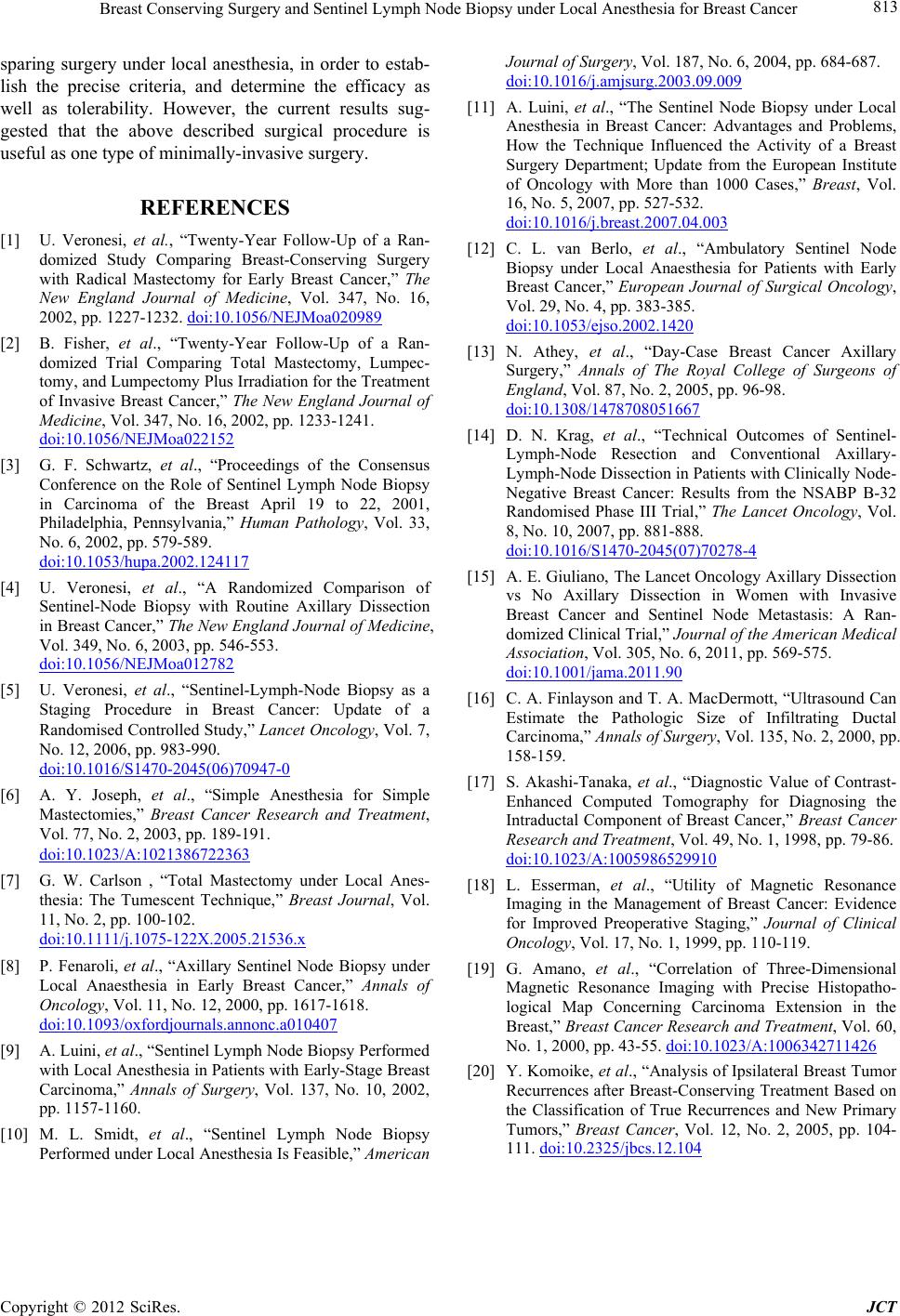
Breast Conserving Surgery and Sentinel Lymph Node Biopsy under Local Anesthesia for Breast Cancer
Copyright © 2012 SciRes. JCT
813
sparing surgery under local anesthesia, in order to estab-
lish the precise criteria, and determine the efficacy as
well as tolerability. However, the current results sug-
gested that the above described surgical procedure is
useful as one type of minimally-invasive surgery.
REFERENCES
[1] U. Veronesi, et al., “Twenty-Year Follow-Up of a Ran-
domized Study Comparing Breast-Conserving Surgery
with Radical Mastectomy for Early Breast Cancer,” The
New England Journal of Medicine, Vol. 347, No. 16,
2002, pp. 1227-1232. doi:10.1056/NEJMoa020989
[2] B. Fisher, et al., “Twenty-Year Follow-Up of a Ran-
domized Trial Comparing Total Mastectomy, Lumpec-
tomy, and Lumpectomy Plus Irradiation for the Treatment
of Invasive Breast Cancer,” The New England Journal of
Medicine, Vol. 347, No. 16, 2002, pp. 1233-1241.
doi:10.1056/NEJMoa022152
[3] G. F. Schwartz, et al., “Proceedings of the Consensus
Conference on the Role of Sentinel Lymph Node Biopsy
in Carcinoma of the Breast April 19 to 22, 2001,
Philadelphia, Pennsylvania,” Human Pathology, Vol. 33,
No. 6, 2002, pp. 579-589.
doi:10.1053/hupa.2002.124117
[4] U. Veronesi, et al., “A Randomized Comparison of
Sentinel-Node Biopsy with Routine Axillary Dissection
in Breast Cancer,” The New England Journal of Medicine,
Vol. 349, No. 6, 2003, pp. 546-553.
doi:10.1056/NEJMoa012782
[5] U. Veronesi, et al., “Sentinel-Lymph-Node Biopsy as a
Staging Procedure in Breast Cancer: Update of a
Randomised Controlled Study,” Lancet Oncology, Vol. 7,
No. 12, 2006, pp. 983-990.
doi:10.1016/S1470-2045(06)70947-0
[6] A. Y. Joseph, et al., “Simple Anesthesia for Simple
Mastectomies,” Breast Cancer Research and Treatment,
Vol. 77, No. 2, 2003, pp. 189-191.
doi:10.1023/A:1021386722363
[7] G. W. Carlson , “Total Mastectomy under Local Anes-
thesia: The Tumescent Technique,” Breast Journal, Vol.
11, No. 2, pp. 100-102.
doi:10.1111/j.1075-122X.2005.21536.x
[8] P. Fenaroli, et al., “Axillary Sentinel Node Biopsy under
Local Anaesthesia in Early Breast Cancer,” Annals of
Oncology, Vol. 11, No. 12, 2000, pp. 1617-1618.
doi:10.1093/oxfordjournals.annonc.a010407
[9] A. Luini, et al., “Sentinel Lymph Node Biopsy Performed
with Local Anesthesia in Patients with Early-Stage Breast
Carcinoma,” Annals of Surgery, Vol. 137, No. 10, 2002,
pp. 1157-1160.
[10] M. L. Smidt, et al., “Sentinel Lymph Node Biopsy
Performed under Local Anesthesia Is Feasible,” American
Journal of Surgery, Vol. 187, No. 6, 2004, pp. 684-687.
doi:10.1016/j.amjsurg.2003.09.009
[11] A. Luini, et al., “The Sentinel Node Biopsy under Local
Anesthesia in Breast Cancer: Advantages and Problems,
How the Technique Influenced the Activity of a Breast
Surgery Department; Update from the European Institute
of Oncology with More than 1000 Cases,” Breast, Vol.
16, No. 5, 2007, pp. 527-532.
doi:10.1016/j.breast.2007.04.003
[12] C. L. van Berlo, et al., “Ambulatory Sentinel Node
Biopsy under Local Anaesthesia for Patients with Early
Breast Cancer,” European Journal of Surgical Oncology,
Vol. 29, No. 4, pp. 383-385.
doi:10.1053/ejso.2002.1420
[13] N. Athey, et al., “Day-Case Breast Cancer Axillary
Surgery,” Annals of The Royal College of Surgeons of
England, Vol. 87, No. 2, 2005, pp. 96-98.
doi:10.1308/1478708051667
[14] D. N. Krag, et al., “Technical Outcomes of Sentinel-
Lymph-Node Resection and Conventional Axillary-
Lymph-Node Dissection in Patients with Clinically Node-
Negative Breast Cancer: Results from the NSABP B-32
Randomised Phase III Trial,” The Lancet Oncology, Vol.
8, No. 10, 2007, pp. 881-888.
doi:10.1016/S1470-2045(07)70278-4
[15] A. E. Giuliano, The Lancet Oncology Axillary Dissection
vs No Axillary Dissection in Women with Invasive
Breast Cancer and Sentinel Node Metastasis: A Ran-
domized Clinical Trial,” Journal of the American Medical
Association, Vol. 305, No. 6, 2011, pp. 569-575.
doi:10.1001/jama.2011.90
[16] C. A. Finlayson and T. A. MacDermott, “Ultrasound Can
Estimate the Pathologic Size of Infiltrating Ductal
Carcinoma,” Annals of Surgery, Vol. 135, No. 2, 2000, pp.
158-159.
[17] S. Akashi-Tanaka, et al., “Diagnostic Value of Contrast-
Enhanced Computed Tomography for Diagnosing the
Intraductal Component of Breast Cancer,” Breast Cancer
Research and Treatment, Vol. 49, No. 1, 1998, pp. 79-86.
doi:10.1023/A:1005986529910
[18] L. Esserman, et al., “Utility of Magnetic Resonance
Imaging in the Management of Breast Cancer: Evidence
for Improved Preoperative Staging,” Journal of Clinical
Oncology, Vol. 17, No. 1, 1999, pp. 110-119.
[19] G. Amano, et al., “Correlation of Three-Dimensional
Magnetic Resonance Imaging with Precise Histopatho-
logical Map Concerning Carcinoma Extension in the
Breast,” Breast Cancer Research and Treatment, Vol. 60,
No. 1, 2000, pp. 43-55. doi:10.1023/A:1006342711426
[20] Y. Komoike, et al., “Analysis of Ipsilateral Breast Tumor
Recurrences after Breast-Conserving Treatment Based on
the Classification of True Recurrences and New Primary
Tumors,” Breast Cancer, Vol. 12, No. 2, 2005, pp. 104-
111. doi:10.2325/jbcs.12.104